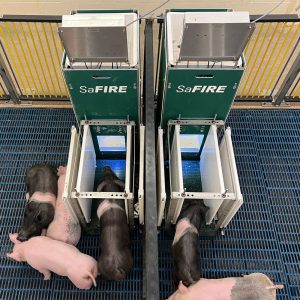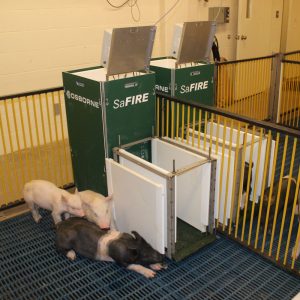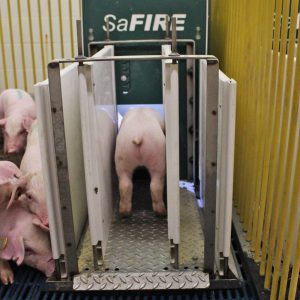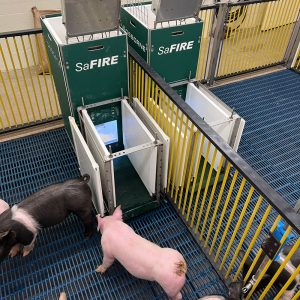SaFIRE
The SaFIRE (Small Animal Feed Intake Recording Equipment) system is the industry’s first feeding system that completely automates the measurement of individual daily feed intake and growth characteristics of small, nursery-sized pigs. Harnessing the proven technology of the FIRE performance testing feeder, the worldwide standard in performance testing of finishing animals, SaFIRE provides access to critical feeding and growth data for 14 to 50 lb. (6 to 23 kg) pigs housed in groups.
About
SaFIRE automatically monitors individual animal feed intake and growth rates of nursery-sized animals in commercially realistic groups of 12-15. Understanding individual animal performance at a young age reflects individual performance in the finishing cycle. Now, genetics companies can use this correlation and the data collected automatically by SaFIRE to assist in selecting superior-performing animals at an earlier age.
Test feed and feed additives with SaFIRE and how they affect animal growth and eating habits. Unbiased, automated data collection ensures results from tests are fully accurate.

SaFIRE Feeder & Weigh Race
SaFIRE (Small Animal Feed Intake Recording Equipment) is the first and only performance testing feeder for small pigs that fully automates the measurement of individual animal daily feed intake. The feeder’s feed trough is suspended on a sensitive, yet robust, load cell that continuously weighs the trough and feed. The trough mount and load cell are protected by an isolation mechanism and a sturdy enclosure that houses a highly accurate feed dispensing system. Harnessing the same technology as the original FIRE System, SaFIRE automatically stores the time and duration of each visit, the weight of feed consumed, and individual animal body weights.

WinFIRE RT Software
The WinFIRE RT Software application for Windows collects, stores, and displays all the information collected by the SaFIRE System for monitoring feeder operation, reviewing animal or group feed intake information, individual growth trends, and more. Real-time and even remote access to up-to-the-minute data collected by SaFIRE is possible with WinFIRE RT and is included with all new systems.
Each SaFIRE Feeder in a pen accommodates 12 to 15 animals from about 14 lbs. (6 kg) to 50 lbs. (23 kg), when feed intake data is critically needed. Because SaFIRE uses RFID (radio frequency identification) technology to identify animals, each animal is tagged with an RFID tag. An antenna inside the SaFIRE Feeder identifies animals at the feeder by their unique RFID. Total feed intake of each individual animal is recorded as it visits along with the individual weight of the animal. A network of highly sensitive load cells under SaFIRE’s Weigh Race automatically records individual body weights as animals visit the feeder. The WinFIRE RT Software maintains a database of information collected in real-time from SaFIRE for each individual animal. WinFIRE RT allows users to make sound genetic selection, management, financial decisions.
Because SaFIRE automates the measurement of both feed intake and growth performance, older, manual methods of testing animals is completely eliminated. Testing with SaFIRE faithfully simulates the actual commercial production practice of nursery-sized pigs.
- Completely automates the measurement of individual feed intake and growth performance of small pigs in groups
- Accurate commercial production simulation
- More accurate than manual testing animals in single pens
- Eliminates data collection errors and operator bias
- Provides diagnostics for animal health and behavior
- Assists in identifying superior performing animals or the effects of specific feedstuffs or feed additives
- Separate, sensitive load cells accurately weigh feed and animals
- Strong construction for years of use
The SaFIRE Feeder will accept up to 12-15 animals per station. Feeding more animals on the station than what is recommended can put additional feeding pressure on the animals, which will influence and bias the results to a particular behavior type. It is recommended that pigs be between approximately 14 lbs. (6 kg) and 50 lbs. (23 kg) to use the SaFIRE Feeder. For pigs over 50 lbs. (23 kg), FIRE (Feed Intake Recording Equipment) should be used.
The SaFIRE Feeder is designed to operate in a livestock environment. Exposure to dust, dirt, high humidity, corrosive gases, and manure is expected, and the equipment is designed for this, with sealed electronic and electrical components, and plastic and hot-dipped galvanized steel/304 stainless steel structural components. Cleaning to remove any manure or debris build-up from around and under the SaFIRE station weigh scale helps in preventing interference with the weighing mechanisms.
Each SaFIRE Feeder is equipped with a weigh race that provides a visiting animal with protection from all sides, except the rear. This provides the greatest degree of protection to a visiting animal without confining each animal to prevent competition. The greatest factor affecting the “bullying” behavior with a SaFIRE Feeder is the number of animals placed in the pen. Staying within the recommendations of 12 to 15 animals per station typically eliminates the bullying behavior problems by allowing plenty of time for all animals to visit the feeder to eat.
SaFIRE is an ad-libitum feeding system. A small amount of feed is always maintained in the feed trough. The trough is constantly weighed so that any disappearance of feed can be recorded as a consumed meal. If the weight of the trough falls below a set value, an additional portion of feed is dispensed into the trough. The accuracy of feed consumption while dispensing feed during a meal is maintained through the use of the system’s proprietary Dynamic Portion Calibration (DPC) algorithms.
A small amount of feed is always maintained in the trough of the SaFIRE Feeder. Feed consumption, or feed disappearance, is recorded for each animal visit. In the case where one animal displaces another which is currently eating, a trough weight is captured between the end of the first visit and the beginning of the second visit, allowing the system to accurately record each animal’s meal independently. When the same animal visits the feeder within a five minute time period, the events are merged and recorded as a single visit to the feeder.






